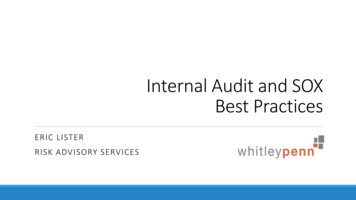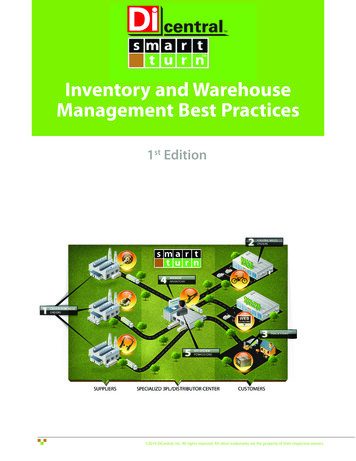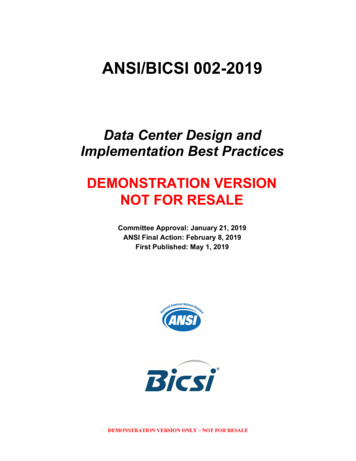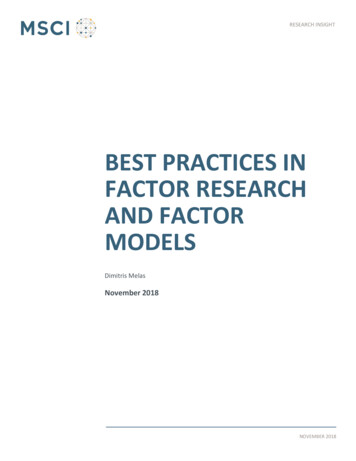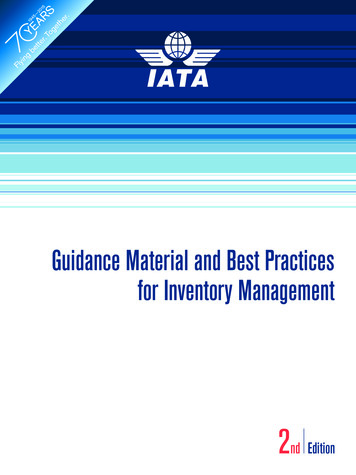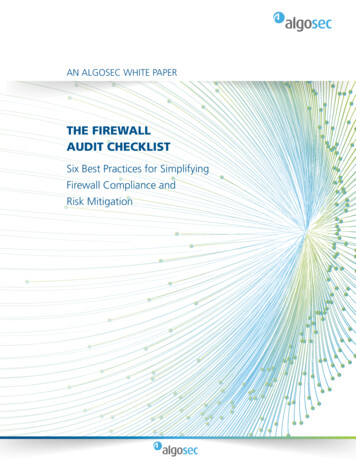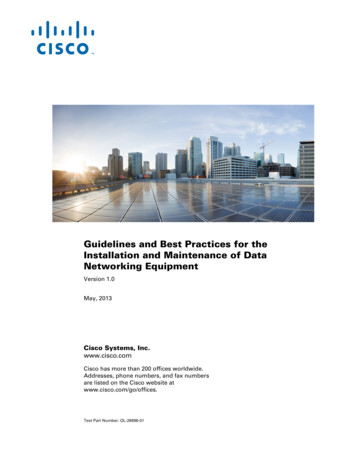
Transcription
Guidelines and Best Practices for theInstallation and Maintenance of DataNetworking EquipmentVersion 1.0May, 2013Cisco Systems, Inc.www.cisco.comCisco has more than 200 offices worldwide.Addresses, phone numbers, and fax numbersare listed on the Cisco website atwww.cisco.com/go/offices.Text Part Number: OL-28696-01
THE SPECIFICATIONS AND INFORMATION REGARDING THE PRODUCTS IN THIS MANUAL ARE SUBJECT TO CHANGE WITHOUT NOTICE. ALLSTATEMENTS, INFORMATION, AND RECOMMENDATIONS IN THIS MANUAL ARE BELIEVED TO BE ACCURATE BUT ARE PRESENTED WITHOUTWARRANTY OF ANY KIND, EXPRESS OR IMPLIED. USERS MUST TAKE FULL RESPONSIBILITY FOR THEIR APPLICATION OF ANY PRODUCTS.THE SOFTWARE LICENSE AND LIMITED WARRANTY FOR THE ACCOMPANYING PRODUCT ARE SET FORTH IN THE INFORMATION PACKET THATSHIPPED WITH THE PRODUCT AND ARE INCORPORATED HEREIN BY THIS REFERENCE. IF YOU ARE UNABLE TO LOCATE THE SOFTWARE LICENSEOR LIMITED WARRANTY, CONTACT YOUR CISCO REPRESENTATIVE FOR A COPY.The Cisco implementation of TCP header compression is an adaptation of a program developed by the University of California, Berkeley (UCB) as part of UCB’s publicdomain version of the UNIX operating system. All rights reserved. Copyright 1981, Regents of the University of California.NOTWITHSTANDING ANY OTHER WARRANTY HEREIN, ALL DOCUMENT FILES AND SOFTWARE OF THESE SUPPLIERS ARE PROVIDED “AS IS” WITHALL FAULTS. CISCO AND THE ABOVE-NAMED SUPPLIERS DISCLAIM ALL WARRANTIES, EXPRESSED OR IMPLIED, INCLUDING, WITHOUTLIMITATION, THOSE OF MERCHANTABILITY, FITNESS FOR A PARTICULAR PURPOSE AND NONINFRINGEMENT OR ARISING FROM A COURSE OFDEALING, USAGE, OR TRADE PRACTICE.IN NO EVENT SHALL CISCO OR ITS SUPPLIERS BE LIABLE FOR ANY INDIRECT, SPECIAL, CONSEQUENTIAL, OR INCIDENTAL DAMAGES, INCLUDING,WITHOUT LIMITATION, LOST PROFITS OR LOSS OR DAMAGE TO DATA ARISING OUT OF THE USE OR INABILITY TO USE THIS MANUAL, EVEN IF CISCOOR ITS SUPPLIERS HAVE BEEN ADVISED OF THE POSSIBILITY OF SUCH DAMAGES.Cisco and the Cisco logo are trademarks or registered trademarks of Cisco and/or its affiliates in the U.S. and other countries. To view a list of Cisco trademarks, go to thisURL: www.cisco.com/go/trademarks. Third-party trademarks mentioned are the property of their respective owners. The use of the word partner does not imply a partnershiprelationship between Cisco and any other company. (1110R)Any Internet Protocol (IP) addresses and phone numbers used in this document are not intended to be actual addresses and phone numbers. Any examples, command displayoutput, network topology diagrams, and other figures included in the document are shown for illustrative purposes only. Any use of actual IP addresses or phone numbers inillustrative content is unintentional and coincidental.Guidelines and Best Practices for the Installation and Maintenance of Data Networking Equipment 2013 Cisco Systems, Inc. All rights reserved.
-1Document Organization 1-2Information ClassificationDocument Conventions1-21-3Importance of InstallationImportance of Maintenance1-31-3Types of Maintenance Programs 1-3Reactive Maintenance 1-4Preventive Maintenance 1-4Predictive Maintenance 1-5Reliability-Centered MaintenanceIndustry StandardsCHAPTER2Installation1-51-52-1Cabling 2-1Frequently Missed RequirementsGuidelines 2-2Best Practices 2-82-1Grounding 2-10Introduction 2-11Frequently Missed RequirementsGuidelines 2-17Best Practices 2-182-11Electrostatic Discharge (ESD) 2-18Introduction 2-18Frequently Missed RequirementsGuidelines 2-26Best Practices 2-272-19Airflow 2-31Introduction 2-31Frequently Missed Requirements2-31Guidelines and Best Practices for the Installation and Maintenance of Data Networking EquipmentOL-28696-01iii
ContentsBest Practices2-31Mechanical Assembly 2-32Frequently Missed RequirementsBest Practices 2-332-32Faceplates 2-34Introduction 2-34Frequently Missed Requirements2-34Optical Connectors and Ports 2-35Introduction 2-35Frequently Missed Requirements2-35Surge Protection 2-37Introduction 2-38Best Practices 2-39Temperature and Humidity 2-39Introduction 2-39Frequently Missed RequirementsGuidelines 2-40Best Practices 2-41CHAPTER3Maintenance2-393-1Dust and Particulates 3-1Introduction 3-1Frequently Missed RequirementsGuidelines 3-5Best Practices 3-73-2Corrosion 3-10Introduction 3-10Frequently Missed RequirementsGuidelines 3-13Best Practices 3-173-12Temperature and Humidity 3-18Introduction 3-18Frequently Missed RequirementsGuidelines 3-20Best Practices 3-213-18Grounding 3-22Guidelines 3-22Best Practices 3-22Guidelines and Best Practices for the Installation and Maintenance of Data Networking EquipmentivOL-28696-01
ContentsSurge Protection 3-23Guidelines 3-23Best Practices 3-23ESD Protection 3-23Introduction 3-23Frequently Missed RequirementsGuidelines 3-25Best Practices 3-253-23Fire Suppression 3-26Introduction 3-26Best Practices 3-27Access Control 3-28Introduction 3-28Best Practices 3-28Maintenance Schedules 3-30Introduction 3-30Frequently Missed RequirementsGuidelines 3-31Best Practices 3-313-31GLOSSARYINDEXGuidelines and Best Practices for the Installation and Maintenance of Data Networking EquipmentOL-28696-01v
ContentsGuidelines and Best Practices for the Installation and Maintenance of Data Networking EquipmentviOL-28696-01
C H A P T E R1IntroductionThis chapter describes the purpose, audience, and organization of this document. It also describes theimportance of installation, maintenance, outlines types of maintenance programs, and lists relevantindustry standards. Purpose, page 1-1 Audience, page 1-1 Document Organization, page 1-2 Document Conventions, page 1-3 Importance of Installation, page 1-3 Importance of Maintenance, page 1-3 Types of Maintenance Programs, page 1-3 Industry Standards, page 1-5PurposeThis document provides general guidelines and best practices to follow during the installation andmaintenance of Cisco's data networking equipment. These guidelines and best practices are based onempirical data and years of experience conducting field assessments and applying industry standards.They should be referred to in conjunction with the requirements that are outlined in the respectiveinstallation guides of Cisco data networking equipment. This document also describes requirements thatare frequently missed by customers and partners in the installation sites.Refer to the product documentation of the Cisco products that are mentioned in this document for moreinformation on the relevant safety warnings for each.AudienceThis document is meant for customers or Cisco qualified personnel who are responsible for theinstallation and maintenance of data networking equipment in an installation site.Guidelines and Best Practices for the Installation and Maintenance of Data Networking EquipmentOL-28696-011-1
Chapter 1IntroductionDocument OrganizationDocument OrganizationTitleDescriptionChapter 1, “Introduction”Describes the importance of installationand maintenance; outlines types ofmaintenance programs; and lists therelevant industry standards.Chapter 2, “Installation”Outlines the installation guidelines andbest practices to follow for datanetworking equipment. It also outlinessome installation requirements that arefrequently missed by customers andpartners.Chapter 3, “Maintenance”Outlines the guidelines and best practicesto follow during the maintenance of datanetworking equipment. It also outlinessome maintenance requirements that arefrequently missed by customers andpartners.Information ClassificationInformation in the subsequent chapters is classified as outlined in Table 1-1.Table 1-1Information ClassificationClassificationDescriptionFrequently MissedRequirementsRequirements that are already outlined in the installation guides of Ciscodata networking equipment, but are often missed during installation. Theserequirements are supported by images of correct and/or incorrectimplementation practices.GuidelinesRecommended methods of implementing requirements that are alreadyoutlined in the existing installation guides of Cisco data networkingequipment.While these guidelines are not mandatory, they support the successfulimplementation of requirements in the field especially when multiplemethods are possible.Best PracticesRefer to tasks, processes, methods, or techniques that are not required, butif implemented, provide benefits to customers and partners to betteroperate their equipment.They originate from lessons learned in the field by Cisco personnel,industry standards, and so on.Guidelines and Best Practices for the Installation and Maintenance of Data Networking Equipment1-2OL-28696-01
Chapter 1IntroductionDocument ConventionsDocument ConventionsNoteMeans reader take note. Notes contain helpful suggestions or references to material not covered in thedocument.Importance of InstallationA faulty or incomplete installation of Cisco data networking equipment can lead to improper functioningor premature failure, and may even limit the possibility of performing effective maintenance. Eventhough the installation procedures are outlined in the Cisco installation guides, additional installationrecommendations are included in Chapter 2, “Installation”.Importance of MaintenanceRegular equipment maintenance ensures that each device runs efficiently during its intended life span.Maintenance refers to all the actions that are performed to prevent a piece of equipment from failing, orto repair a failed or damaged piece of equipment. Therefore, maintenance is essentially a time-based orequipment-based function, which can be categorized based on when it is performed.The benefits of conducting maintenance activities are as follows: An increase in the life span of the equipment, which results in an increase in the operational uptimeof the network. A reduction in hardware failure, which saves operational costs in maintaining the network. An increase in the productivity of the operational resources.For more information on the different types of maintenance programs, see the “Types of MaintenancePrograms” section on page 1-3.Types of Maintenance ProgramsThe following types of maintenance programs are performed on most types of equipment: Reactive Maintenance, page 1-4 Preventive Maintenance, page 1-4 Predictive Maintenance, page 1-5 Reliability-Centered Maintenance, page 1-5NoteThis document covers only preventive maintenance programs in detail in the subsequentchapters.Based on the type of environment in a customer’s network, the customer or partner can choose themaintenance program that aligns to their business requirement.Guidelines and Best Practices for the Installation and Maintenance of Data Networking EquipmentOL-28696-011-3
Chapter 1IntroductionTypes of Maintenance ProgramsReactive MaintenanceReactive maintenance, also known as breakdown maintenance, is one of the most commonly adoptedapproaches and refers to the actions that are performed to restore a failed piece of equipment to bring itback to a workable condition. It is typically performed when the equipment needs to be replaced.The advantages of a reactive maintenance program may include the following: It is cost-effective as the maintenance activity is performed only when the equipment breaks down.Therefore, there is no cost incurred till such time. It is not labor-intensive as manpower is not utilized to perform periodic maintenance activities.The disadvantages of a reactive maintenance program may include the following: It leads to increased long-term equipment costs due to failures that can be severe or catastrophicduring operational hours. Unplanned failures may also result in significant financial impact to thebusiness. It leads to an increased labor cost if an overtime is required to compensate for the equipmentdowntime. The cost of replacing the failed or damaged piece of equipment. The probable damage to secondary equipment (assuming that it is kept in the same environment asthe primary equipment) due to the failure in the primary equipment.Preventive MaintenancePreventive maintenance refers to the maintenance of equipment on a time-based schedule. It is based onthe premise that many instances of equipment failure or malfunction can be prevented if acomprehensive maintenance schedule is followed.The advantages of a preventive maintenance program may include the following: It is predictable and therefore makes budgeting and planning easier. It leads to reduced energy usage thereby increasing energy savings. For example, if the air filtersare periodically cleaned, they are more efficient and consume less power to effectively operate thefans. It provides flexibility and periodicity of maintenance schedules. It increases the life cycle of the individual components of a piece of equipment. It provides a sense of assurance that the equipment is properly maintained and functioning asdesigned. It reduces the frequency and severity of equipment failure and malfunction, which helps to increasethe operational uptime of the network.The disadvantages of a preventive maintenance program may include the following: It is time-consuming and labor-intensive. It does not consider the current state of the equipment before the maintenance activity is performed.Guidelines and Best Practices for the Installation and Maintenance of Data Networking Equipment1-4OL-28696-01
Chapter 1IntroductionIndustry StandardsPredictive MaintenancePredictive maintenance, also known as condition-based maintenance, refers to the actions that areperformed on a piece of equipment when one or more conditions are met. These conditions indicatewhen a piece of equipment is about to fail or deteriorate in performance based on the data that is gatheredafter observing the state of the equipment. Technological advancement in equipment monitoring has leadto the development of tools that help maintenance personnel gather and analyze condition data, and thenperform maintenance on a piece of equipment at the appropriate time.The
installation and maintenance of data networking equipment version 1.0 may, 2013 text part number: ol-28696-01. the specifications and information regarding the products in this manual are subject to change without notice. all statements, information, and recommendations in this manual are believed to be accurate but are presented without warranty of any kind, express or implied. users must .






